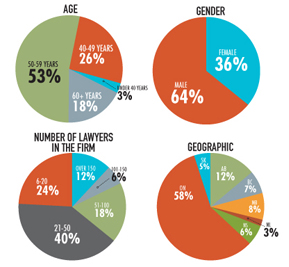 And now for some of the results!
And now for some of the results!
When asked how leaders in their firms were chosen, there was a dead tie at 47 per cent each for “leaders evolve and no election necessary” and “by election.” While we have no evidence other than conjecture, I would imagine that there has been an erosion of the “leaders evolve and no election necessary” category due to both the growth in the size of firms and the challenges faced by the legal profession.
Those surveyed were asked to rank the importance of various competencies for a leader to be successful in their firms. The rankings they used were: critical, important, somewhat important, and not important. The competencies a significant number of responders ranked critical were: communication (written, oral) at 76 per cent; decision making a judgment at 72 per cent; and interpersonal at 66 per cent. The competencies a significant number of responders ranked important were: financial at 70 per cent; business acumen at 70 per cent; sense of urgency at 60 per cent; and managing underperformance at 60 per cent.
"the leader of the past knew how to tell... the leader of the future will know how to ask...” |
When asked about 2013 and the complexities facing the legal profession, 83 per cent predicted next year will be even more challenging than 2012. This certainly seems to jive with much of the news from south of the border where some are predicting up to five Am Law Top 200 firms could dissolve in 2013 and revenue growth peaked in Q1 2012 and has declined steadily, resulting in actual negative growth in Q3 2012.
The speakers also shared that firms’ profits are being squeezed as a result of flat or declining revenue and higher cost structures for delivering services as a result of de-hiring younger associates and being left with more expensive senior associates and salaried partners to do the work.
And if I have not ruined your day sufficiently, Mattern & Associates LLC shared the results of its 2012 survey at this same conference and it indicated the charges for electronic legal research were now receiving the highest degree of “push back” by clients. Yes, more interesting times lay ahead of us.
The survey asked participants to rate on a scale of 1 to 9 (1 being the greatest challenge) what had put leadership to the greatest test in the past 12 months and the answers in order of greatest challenge were:
- Managing conflict — 2.9;
- Hitting profit targets — 3.1;
- Partner upheaval/revolt — 4.3;
- Firm crisis — 4.5;
- Changes in competition — 5.0;
- Financial crisis — 5.4;
- PR, media — 6.2;
- Merger — 6.2;
- Unexpected death — 6.8.
I am reminded of the phrase “misery loves company” and expect if many firms (but not all) were to openly discuss their challenges they would not dramatically change this order. Obviously narrower issues such as business development (skills and approach), succession planning, and talent management are embedded in a number of the above challenges.
"...how future leaders |
It would not be a survey on leadership if didn’t ask how future leaders are developed in your firm. The responses, while likely predictable, do not necessarily provide a warm fuzzy feeling. The approach “we give high potential people opportunities to lead teams and task forces and give them mentoring and feedback in these roles” was selected by 41 per cent of those surveyed; “we give high potential people opportunities to lead and they will figure it out” was selected by 29 per cent; and “we don’t do anything” was selected by 15 per cent of those surveyed. It seems like a fairly cavalier approach to such a mission critical role.
In looking at what were the mission critical duties of law firm leaders it only increases the concern over both the leader’s selection and training process followed by law firms. The survey asked participants to rate on a scale of 1 to 7 (1 being the most important) what law firm leaders should do/be focused on. They answered:
- Set direction for the firm — 2.3;
- Motivate, mentor and inspire;energize people in the firm at all levels — 2.9;
- Build commitment — 3.0;
- Set a personal example — 4.0;
- Challenge the status quo and create change — 4.6;
- Take direction from the partnership — 4.9.
I don't want to leave you with the wrong impression. Yes, the challenges facing the legal profession are somewhat daunting; yes, law firm leadership is often like pushing a wheelbarrow full of frogs with them jumping in and out at will; and yes, some will fail. But if it were easy everyone would be lined up to do it including the CAs or is that CA-CMA or CA-CMA-CGA or CPA or whatever they are trying to morph themselves into!

